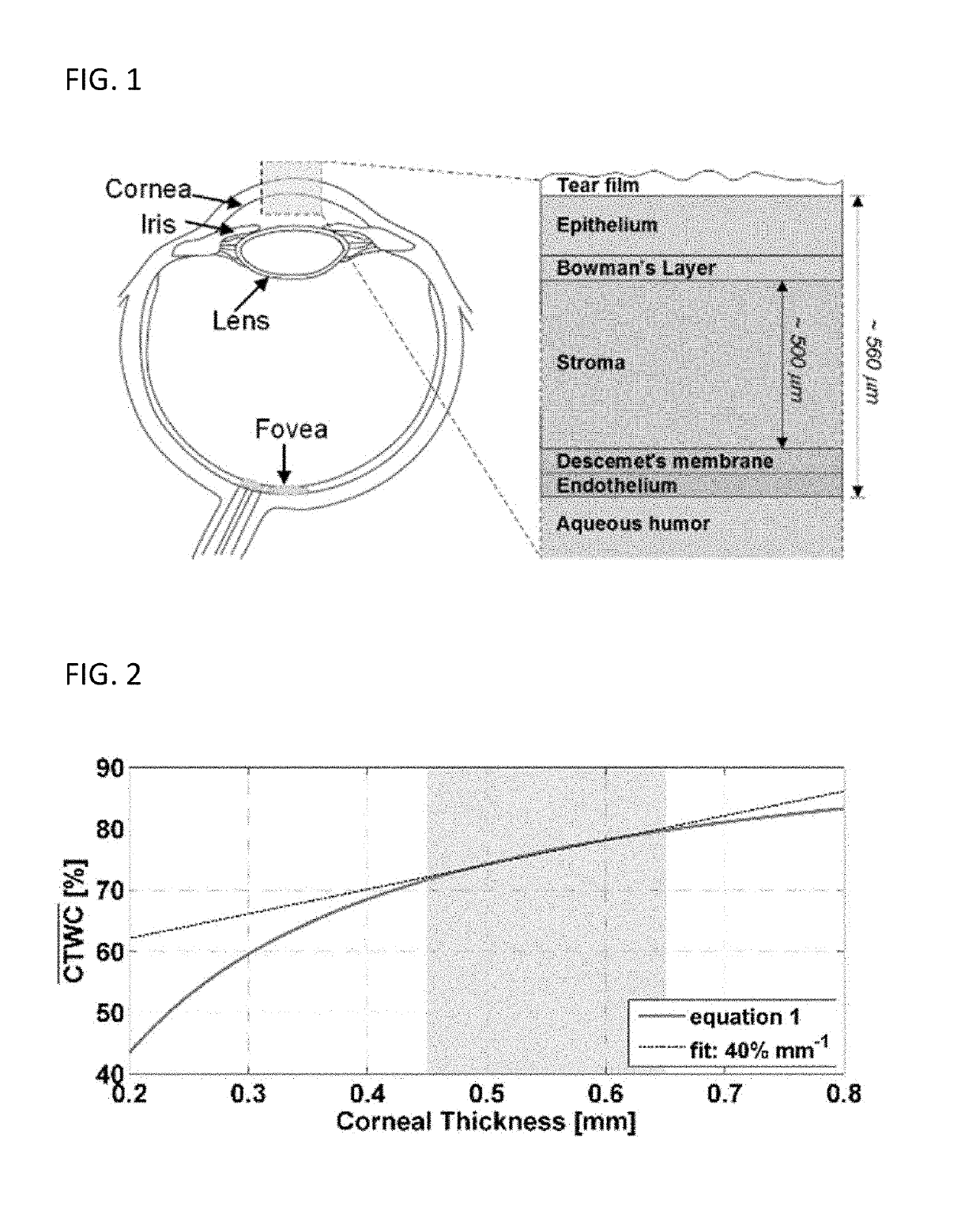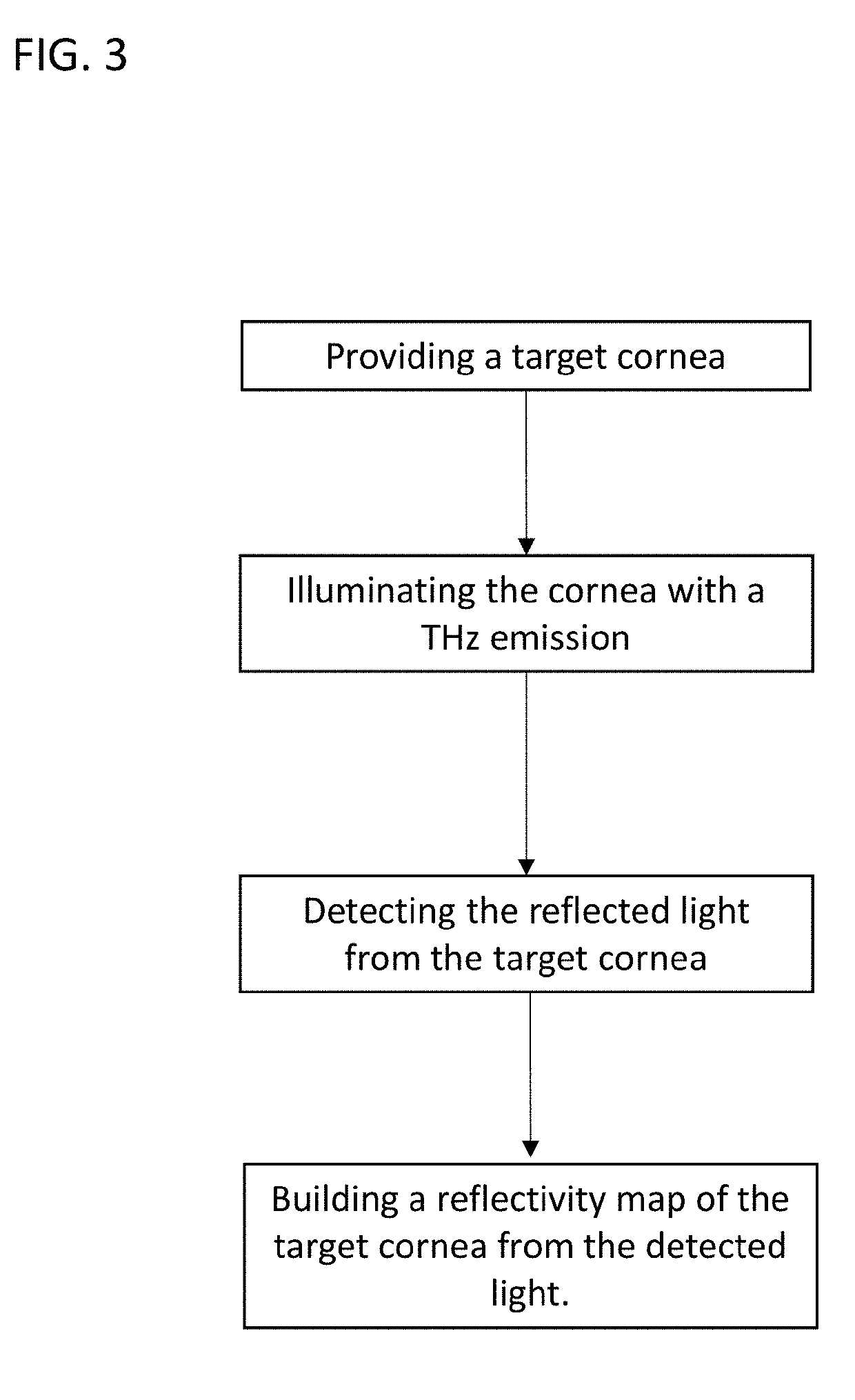THz Sensing of Corneal Tissue Water Content
a corneal tissue and water content technology, applied in the field of thz sensing can solve the problems of corneal tissue water content (ctwc) and subsequent swelling of the cornea, chronic vision impairment, surgical intervention,
- Summary
- Abstract
- Description
- Claims
- Application Information
AI Technical Summary
Benefits of technology
Problems solved by technology
Method used
Image
Examples
example 1
THz Electromagnetic Modeling and Analysis
[0140]Exemplary embodiments exploring the THz spectral properties of human cornea as a function of CCT and corneal water content, and clinically useful models of THz based corneal water content sensing are provided.
[0141]The exemplary embodiment provides a 1D plane wave study of the electromagnetic properties of the cornea. Corneal tissue water content (CTWC) was modeled with a combination of Debye, Bruggeman, and stratified media theory. Reflectivities as a function of frequency, CTWC level, CTWC gradient type, and corneal thickness were computed and then the aggregate reflectivities of subsets of these spaces were explored with four different systems; two centered at 100 GHz and two centered at 525 GHz. Additionally each system was simulated broad band (Q=5) and narrow band (Q=50). The results elucidate the complex relationship between TWC, corneal thickness, and RF reflectivity, and demonstrate the utility of different frequency bands and ...
exemplary embodiment 2
Tissue Water Content
[0197]In Exemplary Embodiment 1, a theoretical 1D wave model and simulation study of the THz frequency properties of the cornea was described, and its implications with respect to functional embodiments of THz corneal imaging / sensing methods and systems described. In particular, the simulations provide evidence concerning how the properties of the lossy etalon effect that arises from the cornea lying in between the aqueous humor and the cornea presents to external radiation, and elucidates the THz electromagnetic properties under simultaneous perturbations of corneal tissue water content (CTWC) and central corneal thickness (CCT). Three exemplary models of tissue water content (TWC) gradient types were explored: (1) pinned back where the CTWC changes occur primarily at the posterior surface, (2) pinned front where the TWC changes occur primarily at the anterior surface close to the aqueous humor, and (3) global where the CTWC modulation occurs evenly throughout t...
exemplary embodiment 3
igns
[0257]In this Exemplary Embodiment, terahertz (THz) imaging system designs incorporating a combination of plane and off axis parabolic (OAP) mirrors to scan a beam at normal incidence across the radial extent of the cornea while keeping the source, detector, and, most importantly, the patient stationary are described in accordance with various embodiments of the invention. In many embodiments, this method acquires an image of a spherical surface with an arbitrary radius of curvature by an orthographic projection of the spherical surface to Cartesian coordinates. The designs result in non-contact imaging of corneal reflectivity and result in the elimination of temporal thickness variations.
[0258]Described within this Exemplary Embodiment is a framework for providing THz imaging / sensing apparatus and methods for performing non-contact imaging of CTWC in human cornea. Imaging principles, quasioptical modeling, and physical optics modeling are also presented. In accordance with mult...
PUM
 Login to View More
Login to View More Abstract
Description
Claims
Application Information
 Login to View More
Login to View More - R&D
- Intellectual Property
- Life Sciences
- Materials
- Tech Scout
- Unparalleled Data Quality
- Higher Quality Content
- 60% Fewer Hallucinations
Browse by: Latest US Patents, China's latest patents, Technical Efficacy Thesaurus, Application Domain, Technology Topic, Popular Technical Reports.
© 2025 PatSnap. All rights reserved.Legal|Privacy policy|Modern Slavery Act Transparency Statement|Sitemap|About US| Contact US: help@patsnap.com



